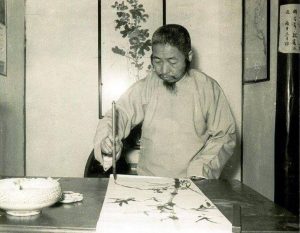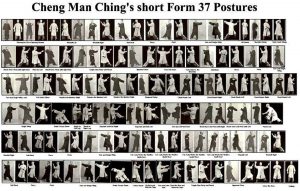IL MAESTRO DELLE CINQUE ARTI
For english text see below
Cheng Man Ching (1901-1975) è il fondatore dello stile di Tai Chi Chuan da noi praticato.
Nasce in Cina a Yongjia (provincia di Zhejiang) nel 1901, si trasferisce a Taiwan nel 1949 e negli Stati Uniti, a New York, nel 1964.
Era detto “Maestro delle cinque arti” per la sua competenza e bravura nella pittura, calligrafia, poesia e Medicina tradizionale cinese, oltre che nel Tai Chi Chuan. Era chiamato anche Professore, perché insegnante al College.

Cheng Man Ching si è avvicinato al Tai Chi Chuan attraverso gli insegnamenti di Yang Chen Fu, uno dei più celebri Maestri del XX secolo.
Il suo contributo a questa pratica è stato soprattutto quello di avere semplificato la forma lunga Yang (la cosiddetta forma 108) codificandone una versione abbreviata di 37 posture. Le differenze più evidenti tra le due forme sono l’eliminazione della maggior parte delle ripetizioni, che rende possibile eseguire la forma in circa 10 minuti invece dei tradizionali 25-30 minuti, e la posizione della mano che rimane in linea con l’avambraccio in una caratteristica postura definita “beautiful lady’s hand” (la mano della bella donna).

La minore lunghezza della forma così ottenuta gli ha permesso di insegnarla a più studenti e in minor tempo. Questa forma “semplificata” ha acquisito molta popolarità a Taiwan, in Malesia e negli Stati Uniti dove Cheng Man Ching è stato uno dei primi maestri cinesi ad insegnare il Tai Chi Chuan agli occidentali.
Per quanto riguarda la definizione della sua forma, Cheng Man Ching ha sempre rifiutato di chiamarla “Forma breve Yang” preferendo invece la definizione “Tai Chi stile Yang in 37 posture”.
____________________________________________________________________________
MASTER OF FIVE EXCELLENCES
Cheng Man Ching (1901-1975) founded the style of Tai Chi Chuan that we practice.
He was born in Yongjia (Zhejiang province) in 1901, moved to Taiwan in 1949 and then to the United States, (New York City) in 1964.
He was called the Master of Five Excellences due to his mastery of painting, calligraphy, poetry, traditional Chinese medicine, and Tai Chi Chuan. He was also called Professor, since he taught at the Chinese universities of the time.
Cheng Man Ching studied closely with Yang Chen Fu, one of the most famous Tai Chi Chuan masters of the XX century, and was one of his last students.
Cheng Man Ching’s principal contribution to Tai Chi is the simplification of the traditional Yang Long Form (108 postures), by abbreviating it to 37 defined postures. The major differences appear in the elimination of many repetitions, so that the sequence can be performed in about 10 minutes. The Long Form requires about 25-30 minutes. The other major difference is the position of the hand, which remains aligned with the wrist; this is called the beautiful lady’s hand.
This abbreviated form allowed Cheng Man Ching to teach the sequence to more students in a shorter length of time. It became quite popular in Taiwan, Malaysia, and in the United States where Cheng Man Ching became one of the first Chinese Tai Chi masters to teach to westerners.
Cheng Man Ching always defined his abbreviated form as Yang-style Tai Chi in 37 postures, and never called it the Yang Short Form.


